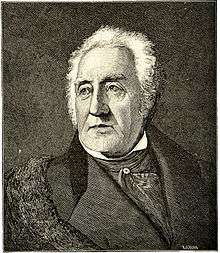Thomas Handasyd Perkins
| Thomas Handasyd Perkins | |
|---|---|
 | |
| Born | December 15, 1764 |
| Died |
January 11, 1854 (aged 89) Brookline, Massachusetts |
| Nationality | American |
| Occupation | Shipping magnate |
| Net worth | USD $3 million at the time of his death (approximately 1/1116 of US GNP)[1] |
Colonel Thomas Handasyd Perkins, or T. H. Perkins (December 15, 1764 – January 11, 1854), was a wealthy Boston merchant and an archetypical Boston Brahmin. Starting with bequests from his grandfather and father-in-law, he amassed a huge fortune. As a young man he was a slave trader in Haiti, a Maritime Fur Trader, trading furs from the American Northwest to China, and then a major smuggler of Turkish opium into China.[2][3]
Life and career
His parents, James Perkins and Elizabeth Peck, had ten children in eighteen years. When Perkins was twelve, he was in the crowd which first heard the Declaration of Independence read to the citizens of Boston. The family had planned to send Perkins to Harvard College, but he had no interest in a college education. In 1779 he began working, and in 1785 when he turned 21 he became legally entitled to a small bequest that had been left to him by his grandfather Thomas Handasyd Peck, a Boston merchant who dealt largely in furs and hats. Until 1793 Perkins engaged in the slave trade at Cap-Haïtien Haiti.
In 1785, when China opened the port of Canton to foreign businesses, Perkins became one of the first Boston merchants to engage in the China trade. He sailed on the Astrea to Canton in 1789 with a cargo including ginseng, cheese, lard, wine, and iron. On the trip back it carried tea and silk cloth. In 1815 Perkins and his brother James opened a Mediterranean office to buy Turkish opium for resale in China.
Perkins was also a major industrial investor within Massachusetts. He owned the Granite Railway, the first commercial American railroad, which was built to carry granite from Quincy quarries to Charlestown for construction of the Bunker Hill Monument and other city buildings in Boston. He also held significant holdings in the Elliot textile mills in Newton, the mills at Holyoke and Lowell, New England canals and railroads, and lead and iron mines including the Monkton Iron Company in Vermont. In addition, Perkins was politically active in the Federalist Party, serving terms as state senator and representative from 1805–1817.
In later years Perkins became a philanthropist. In 1826, he and his brother, James Perkins, contributed half the sum of $30,000 that was needed for an addition to the Boston Athenaeum, and the old Boston Athenaeum Gallery of Art was moved to James Perkins's home.[4] The Perkins School for the Blind, still in existence in Watertown, Massachusetts, was renamed in his honor after he donated his Boston mansion to the financially troubled "Massachusetts Asylum for the Blind" in 1832. He was also a major benefactor to the Boston Museum of Fine Arts, McLean Hospital, and helped found the Massachusetts General Hospital.
Upon retirement, Perkins built a summer home on Swan Island in the Kennebec River near Richmond, Maine. He helped the island achieve independent municipal status by paying legal fees for its charter and the town was renamed Perkins in gratitude. It is now Perkins Township, a ghost town. Colonel Perkins died on January 11, 1854 in Brookline, Massachusetts, and is buried in the family plot at Mount Auburn Cemetery.
Perkins married Sarah "Sally" Elliott (1768-February 25, 1852) on March 25, 1788, in Boston, Massachusetts. They had three children: Colonel Thomas Handasyd Perkins, Jr. ("Short-arm Tom"), whose daughter Louisa married the Boston painter William Morris Hunt;[5] Elizabeth Perkins Cabot (1791–1885); and Caroline Perkins Gardiner (1800–1867). His nephew John Perkins Cushing was active in Perkins' China business for 30 years; the town of Belmont, Massachusetts is named for his estate. His great nephew Charles Callahan Perkins became a well known artist, author and philanthropist like his grandfather James Perkins.
References
- Thomas G. Cary (1856). Memoir of T. H. Perkins.
- Carl Seaburg and Stanley Paterson, Merchant Prince of Boston. Colonel T.H. Perkins, 1764–1854, 1971.
Footnotes
- ↑ Klepper, Michael; Gunther, Michael (1996), The Wealthy 100: From Benjamin Franklin to Bill Gates—A Ranking of the Richest Americans, Past and Present, Secaucus, New Jersey: Carol Publishing Group, p. xiii, ISBN 978-0-8065-1800-8, OCLC 33818143
- ↑ American Merchants and the China Opium Trade, 1800-1840. Jacques M. Downs. Business History Review, Vol. 42, No. 4 (Winter, 1968)
- ↑ American Trade in Opium to China, Prior to 1820. Charles C. Stelle. Pacific Historical Review, Vol. 9, No. 4 (Dec., 1940)
- ↑ The Philanthropy Hall of Fame, Thomas Perkins
- ↑ The History of the Descendants of John Dwight of Dedham, Mass., Benjamin Woodbridge Dwight, J.F. Trow & Co., New York, 1874
Further reading
- Hunt, Freeman (1858). "Thomas Handasyd Perkins". Lives of American Merchants. 1.
- Perkins and Company, Canton 1803-1827. Bulletin of the Business Historical Society, Vol. 6, No. 2 (Mar., 1932). Jstor 3110803.
External links
- Massachusetts Historical Society Thomas Handasyd Perkins papers, 1783-1892 guide
- Portrait of James Perkins, brother of T.H. Perkins